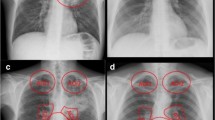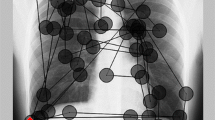Abstract
Objective
Failure to identify fractures is the most common error in accident and emergency departments. Therefore, the current research aimed to understand more about the processes underlying perceptual expertise when interpreting skeletal radiographs.
Materials and methods
Thirty participants, consisting of ten novices, ten intermediates, and ten experts were presented with ten clinical cases of normal and abnormal skeletal radiographs of varying difficulty (obvious or subtle) while wearing eye tracking equipment.
Results
Experts were significantly more accurate, more confident, and faster in their diagnoses than intermediates or novices and this performance advantage was more pronounced for the subtle cases. Experts were also faster to fixate the site of the fracture and spent more relative time fixating the fracture than intermediates or novices and this was again most pronounced for subtle cases. Finally, a multiple linear regression analysis found that time to fixate the fracture was inversely related to diagnostic accuracy and explained 34 % of the variance in this variable.
Conclusions
The results suggest that the performance advantage of expert radiologists is underpinned by superior pattern recognition skills, as evidenced by a quicker time to first fixate the pathology, and less time spent searching the image.




Similar content being viewed by others
Notes
We used a percentage ratio to better illustrate that experts spent more time fixating the fracture and less time searching the image. Indeed, the raw data illustrates that in general experts spent 22.76 (SD = 20.84) seconds fixating the radiographs with 5.70 (SD = 4.90) seconds of this spent focusing on the fracture regardless of case difficulty. Novices and intermediates spent a mean of 58.96 (SD = 39.91) seconds and 39.17 (SD = 17.01) seconds fixating the radiograph and 10.18 (SD = 7.08) and 8.68 (SD = 6.01) seconds fixating the fracture, respectively.
References
Krupinski EA. The importance of perception research in medical imaging. Radiat Med. 2000;18:329–34.
Kundel HL, Nodine CF. A visual concept shapes image perception. Radiology. 1983;146:363–8.
Richler J, Cheung O, Gauthier I. Holistic processing predicts face recognition. Psych Sci. 2011;22:464–71.
Mello-Thoms C. The problem of image interpretation in mammography: Effects of lesion conspicuity on the visual search strategy of radiologists. Br J Radiol. 2006;79:S111–6.
Kundel HL, Nodine CF, Conant EF, Weinstein SP. Holistic component of image perception in mammogram interpretation. Radiology. 2007;242:396–402.
Kundel HL, Nodine CF, Krupinski EA, Mello-Thoms C. Using gaze-tracking data and mixture distribution analysis to support a holistic model for the detection of cancers on mammograms. Acad Radiol. 2008;15:881–6.
Manning DJ, Ethell SC, Donovan T. Detection or decision errors? Missed lung cancer from the posteroanterior chest radiograph. Br J Radiol. 2004;77:231–5.
Manning D, Barker-Mill SC, Donovan T, Crawford T. Time-dependent observer errors in pulmonary module detection. Br J Radiol. 2005;79:342–6.
Manning D, Ethell S, Donovan T, Crawford T. How do radiologists do it? The influence of experience and training on searching for chest nodules. Radiography. 2006;12:134–42.
Nodine CF, Mello-Thoms C, Kundel HL, Weinstein SP. Time course of perception and decision-making during mammographic interpretation. AJR. 2002;179:917–23.
Pinto A, Brunese L. Spectrum of diagnostic errors in radiology. World J Radiol. 2010;2:377–83.
Leong JJH, Nicolaou M, Emery RJ, Darzi AW, Yang G-Z. Visual search behaviour in skeletal radiographs: a cross-speciality study. Clin Radiol. 2007;62:1069–77.
Hu CH, Kundell HL, Nodine CF, Krupinski EA, Toto LC. Searching for bone fractures: a comparison with pulmonary module search. Acad Radiol. 1994;1:25–32.
Kundel HL, Nodine CF, Krupinski EA. Searching for lung nodules. Visual dwell indicates locations of false positive and false-negative decisions. Invest Radiol. 1989;24:472–8.
Myles-Worsley M, Johnston W, Simons MA. The influence of expertise on x-ray image processing. J Exp Psychol Learn Mem Cogn. 1988;14:553–37.
Acknowledgments
The authors declare that they have no conflicts of interest.
Author information
Authors and Affiliations
Corresponding author
Rights and permissions
About this article
Cite this article
Wood, G., Knapp, K.M., Rock, B. et al. Visual expertise in detecting and diagnosing skeletal fractures. Skeletal Radiol 42, 165–172 (2013). https://doi.org/10.1007/s00256-012-1503-5
Received:
Revised:
Accepted:
Published:
Issue Date:
DOI: https://doi.org/10.1007/s00256-012-1503-5




